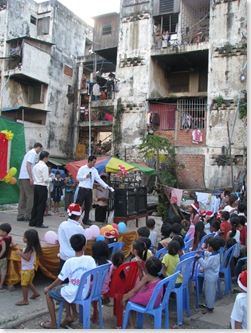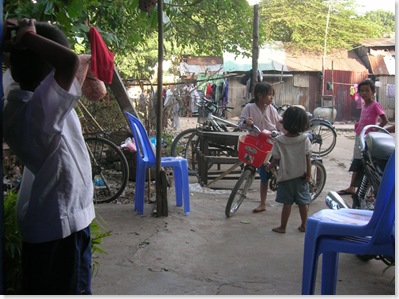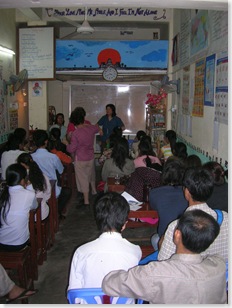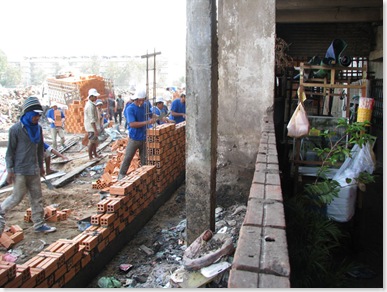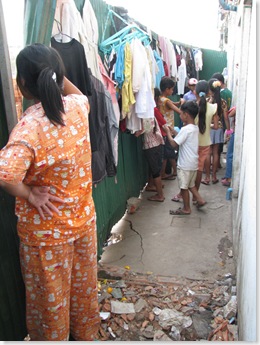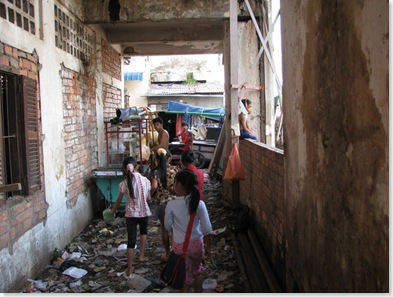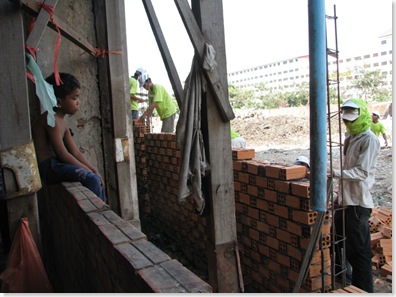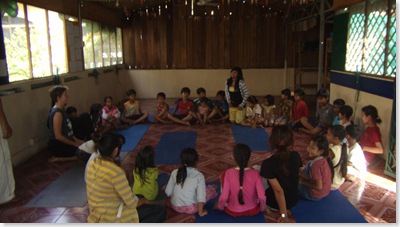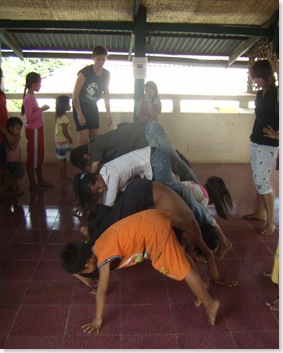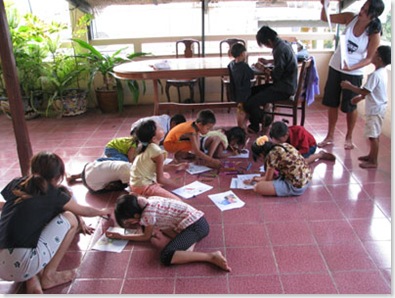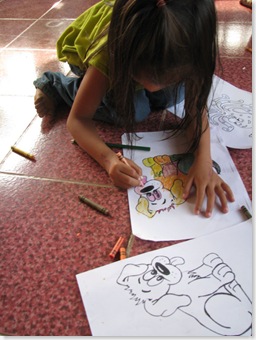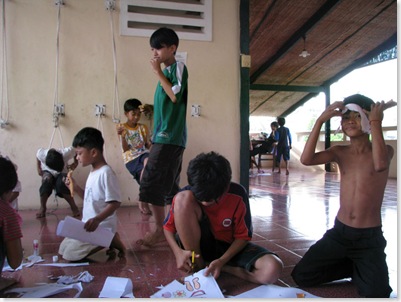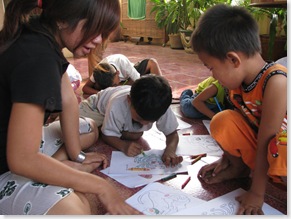The new years—2009 and the Year of the Ox—are here; they have been seen in with celebration, drums, parties, firecrackers, and also bulldozers, tear-gas, and some profound opportunities for practice.
I would like to tell you a story about four NataRaj Yoga teacher trainees . This story begins in an empty schoolroom on the bottom floor of the Van Molyvann Grey Buildings, on the warm side of a corrugated iron fence dividing demolition workers and detritus from the living efforts of a community whose homes have been razed to the ground by bulldozers and small men. Our trainees have been working with the Dey Krahom community and Aziza school for the past three months as part of our studio’s outreach program, and as part of their own teacher training; one of our trainees spent a few years of her own life there; another grew up in a local community not far away, a community that had been forced out of the city two years prior.
And this story begins with another story, the one I told my trainees contextualizing the events that were unrolling on the cold side of the fence.
I told the yogis about a group of people who wanted the land of Dey Krahom because they wanted to make money off it, and they wanted money so badly that they forgot that human beings and families and communities also have value. They tried to bargain for the land with small sums of money and inadequate housing alternatives; and some people took what they were told to take, but 150 families thought the deal was unfair, and so they stayed. That created a conflict.
In a functional society there are laws that most people agree to follow because of a common allegiance to certain social values such as equality or order; and conflicts are resolved not on the basis of upholding one or another person’s personal ambitions, but on upholding those overarching interests. I wished I could tell my yogis that although this “development” of Dey Krahom seemed destructive at first glance, there were larger movements taking place that made it right, and we just had to see things from a broader perspective like when you practice a difficult pose for the sake of learning something new—the immediate experience may be uncomfortable, but there is more to be gained by opening to it than there is by indulging what is easiest.
But, of course, forced evictions, demolition of people’s homes and lives, unfair compensation, intimidation and theft are not done in the name of shared values; they show no respect for law, human life, or the institutions that keep a society coherent; there was no justice taking place at any level of subtlety on the cold side of that fence. Cities evolve, Phnom Penh has been undergoing massive changes in the last couple years, and such changes are never without disruption; shifting an entire community, especially one with so few options to begin with, would invariably be upsetting, but it didn’t need to be violent.
The trainees and I discussed three possible ways the developers could have resolved such a conflict: they could have offer fair compensation, but they had refused to participate if it meant giving something of themselves for the sake of someone else. They could have curbed their own covetous desires in deference to higher principles like the value of human life, but, as most Cambodians know from experience, small men with big pockets in this part of the world are not in the habit of holding back.
Instead, they exercised a third form of power, the I’m-bigger-than-you form of power, the I’m-bigger-than-the-law form of power; and, sadly, they get away with it. Developers in bed with the government have demolished other communities before Dey Krahom; they will continue to take what they want when they want it, and the institutions that run Cambodia will consistently fail to uphold a social conscience, instead aligning themselves with the interests of the wealthy few. Power in this country means you don’t have to care; powerlessness is being forced to care and unable to do anything about it.
And so like the families that had been displaced, like the victims of so many other government initiatives, we sat in silence, baffled by the next step, me feeling vaguely guilty about dropping such a sandbag onto my students without the mechanisms to lift it off again. The questions lurked like the stench of upturned sewage: where does this leave us? What are we doing here?
And, of course, unlike the families and many others, we had some options: we could go home and have a shower and move on with our lives; or, we could go back to the yoga studio and practice; we could send good energy to the land; or breathe in the bad and breathe out the good.... A yogi keeps a whole bag of tricks for such occasions, ways of dispelling the sense of powerlessness in the face of circumstances that cannot be changed.
And so we looked at the tricks we’ve been learning in the studio. We remembered discussions about asana practice as a way of looking at your own limitations, not turning away when you come to a difficult pose, and the techniques we draw on to sustain our strength and clarity; then, investigating and gathering knowledge of the present moment—of our limitations, as well as imaginative possibilities of actions beyond our limitation; and from there creating a pose or a movement infused with agency and self, based on the materials you have, not on what you are missing, manifesting a work that is true to your own body, even if the resultant expression is different from what you thought, or even hoped, it would be.
The yoga practice is a series of loops through the process of finding, investigating and creating. What we came to do at Aziza School that day was find out where we were. We all had different experiences of the place, triggering different associations and emotions in each of us, at different levels of intensity: the environment feels very different to someone who grew up nearby, or someone who was trafficked there as a pre-teen, or someone who only knew it as the spastic and smiling children from Aziza school. But first we needed to look, instead of laughing off the evictions as another helpless and tragic headline, or wearing it like another layer of resentment and armour. And so we took our practice to the schoolroom and held the pose while the trucks clattered at the green fence and the flies flew in our noses, and we watched how our bodies and minds responded.
Having made contact with the matter, we were able to investigate the contours of our experience through sensation and imagination. We moved potted plants around, we swept the skinny strip of cement between the doorway and the wall, we heard the trucks, we remembered the families; my students cried; my students remembered their own stories; Vannac listened to mothers desperately losing their grip on their own lives. We found some parts of our own bodies that day: my students caught glimpses of their feelings of loss and anger, and turned their faces towards parts of their history they had resisted when I first mentioned going to the school. And now they took the time to sit down when they needed to sit; they took the time to touch and hug when they needed the contact. They took the time to give names as best they could to what they felt.
And we discovered that when we take the time to find these places in ourselves, and acknowledge where we are, we generate at the same time an ability to move. Instead of sitting silently under the groans of tractors, or safely on our blue mats in the yoga studio, we were able to join discussions with the staff of Aziza school and arrange ways of getting the kids to the studio so their school time would not be disrupted. We coordinated times to help serve meals and clean up. We cleared a space at the studio for our NataRaj staff member, Kunthea, and her mother and sister who lost their own house that Saturday morning.
Busy-ness can be a way of obscuring our own experiences, but mindful action is a restorative gesture of creativity and part of a healing process. Our small team of yogis noticed that what made us angry at 7NG was that the developers broke things that we believe in: respect for human beings, communities and law, and instead manifested their opposites: violence, disrespect, destruction. We had a choice in our own actions, and we chose not to perpetuate their violence by hating them, or settling ourselves into anger or harbouring a futile hunger for vengeance. Instead, through our actions we chose to reinstate what had been damaged by deliberately bringing into being what we wanted to see. Of course we cannot rebuild the homes, but we can support the community, we can kindle respect for the people whose lives have been shattered and extend kindness to the kids who have been shaken to the ground.
Such is the place for yoga in Cambodia: a yoga studio is not a human rights NGO, we are not activists and advocates; we are diggers and see-ers and healers and artists. My students are recognizing that the practice of yoga means learning to acknowledge our own limitations and still give to others, not as two contradictory gestures but as part of a single healing process. In our practice, we are discovering the quality of those things that cannot be bulldozed, in a country where gross acts of disrespect are the order of the day and pleas for justice will take many many more years to be heard. And we are cultivating the strength in ourselves to hold the pose—to keep our sights on what we believe in and our actions true to those values.
My students did not lose their homes last weekend, but they have suffered their own traumas and erasures of self during their lives, and they continue to embody their losses; what they are practicing now are ways of confronting loss, and they are discovering that there is always something we can do to reinstate what at first glance seems to have been taken away. Touching the tragedy of Dey Krahom is a loop in the lifelong practice of yoga: a dip into feeling, a journey of investigation, and an act of creation. Each time we look, find and then create, we gain confidence and strength to look a little deeper the next time, to look more closely into the body, to keep our eyes open longer, to hold the pose from a different place, a more vulnerable place, a less known place. And as we gain the courage to speak from those spaces, our acts of creation become more authentic, and each expression of our self voices a more deeply held and more meaningful intention.
Since that day at Aziza school, thirty children from Dey Krahom and the Grey Building have been coming to NataRaj for yoga classes, games, relaxation, clean air, and respite from frantic parents and swarms of flies. We have a massive team of volunteers, including Sandra and Tressa, all our trainees, Vannac, our receptionists Dara and Theara, and guards, Piseth (who is also a trainee) and Sothea; there are even a few other people who I don’t really know, all banding together to keep the kids off the ceilings and walls, collecting materials for craft projects, buying food and supplies, breaking up fights, translating, and playing along. For the hours that the kids are out of the Grey Building, the staff of Aziza school are able to meet, or put their heads down, or help the grownups find new places to live or ways of feeding the family.
The Dey Krahom program is proceeding on NataRaj Studio funds which are in short supply at the best of times. We would like to ask for support from the extended yoga community so that we can continue with this project for as long as need be. We have set up a donation box at the front desk of the studio should you be interested in making a contribution: monetary donations are great, as are donations of food and classroom materials, although they probably won’t fit in the box.
Donations will fund transportation and materials for the kids yoga program at NataRaj. Additional funds will be directed to Aziza School in support of the following projects:
· Sponsoring families’ rent at new homes until they are either compensated by the government or re-establish a means of generating income;
· Lunches and dinners being served at Aziza School to families without income or food preparation facilities;
· Supplementary transportation funds for relocated families that must travel into Phnom Penh to work;
· School uniforms, shoes, clothing for the children who lost all their belongings in the demolition;
For those of you on this mailing list that are not living in Cambodia or for anyone interested in learning more about what happened at Dey Krahom, check out the following websites and blogs.
http://www.amnesty.org/en/for-media/press-releases/cambodia-hundreds-left-homeless-after-forced-eviction-20090126
http://blog.onphotographycambodia.com/
http://yourphnompenhpal.blogspot.com/2009/01/human-wrongs-eviction-of-dey-krahorm.html
For more about Aziza School or to make a donation directly to their organization, visit:
http://www.villageearth.org/pages/Projects/Cambodia/Index.php
We extend deep gratitude to all those who support the families of Dey Krahom, and the team of volunteers at NataRaj who are donating their time and efforts to our own small contribution.
And to the members of our NataRaj community in Phnom Penh and overseas, who keep this place up through your ongoing patronage and enthusiasm, thus making such projects and extensions of yoga into the community possible.
And, to John Ang and his students at Living Yoga in Taipei, Taiwan, for their generous support for our outreach programs, and for the sponsorship that has allowed our teacher training course to come into being.
Shanti
